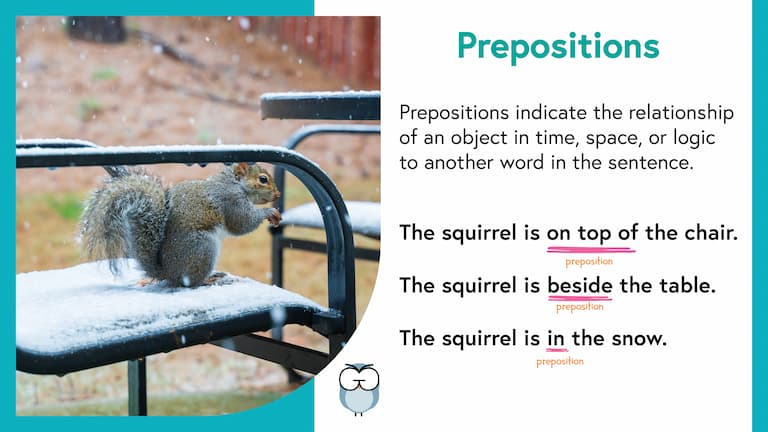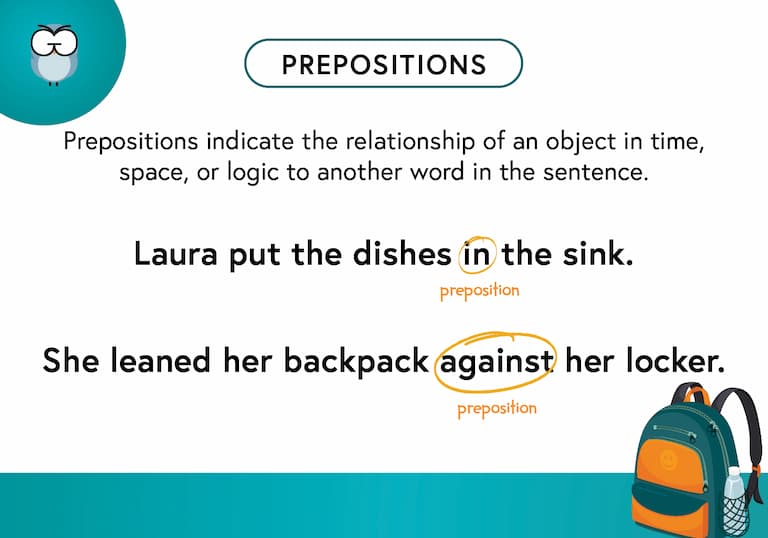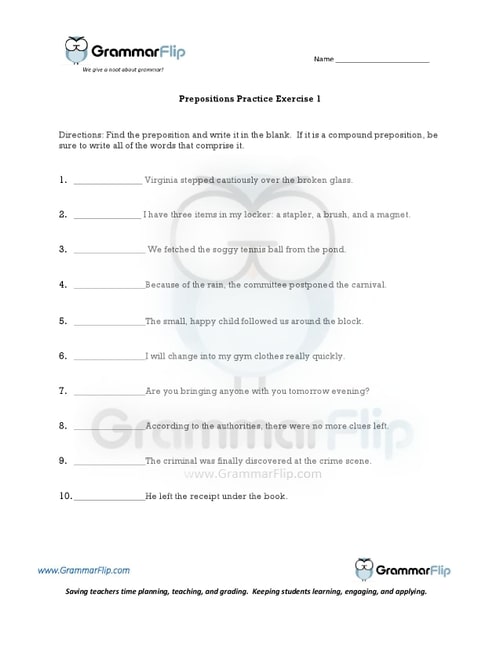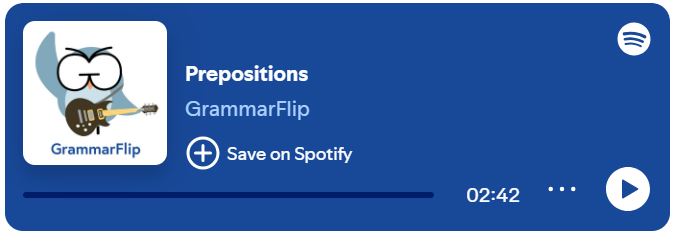What is a Preposition?
A preposition is a word that indicates the relationship of an object in time, space, or logic to another word(s) in the sentence.
Some examples of prepositions would be the following:
Laura, put those dirty dishes in the sink.
Denise drove carefully around the pothole.
Kai is sitting beside Josh on the airplane.
She leaned her backpack against her locker.
He hid the cookies on top of the refrigerator.
My project is not due until Friday.
Mehmet walked his dog in spite of the rain.
Long-Form Videos: Prepositions
Long-form instructional video lessons allow students to engage with grammar concepts in more depth and detail.
This format provides students with a stronger foundation and a more comprehensive understanding of prepositions.
Grammar-in-Context Videos: Prepositions
GrammarFlip’s grammar-in-context videos provide an additional layer of instruction, learning, and relatability.
Our unique and memorable video footage helps solidify the understanding of challenging grammar concepts.
Watch this video to better understand prepositions!
Short-Form Videos: Prepositions
Short-form videos are an excellent way to review grammar concepts. Our two-minute instructional videos help students review the concept of prepositions to further solidify their understanding.
Memorable Images: Prepositions
The use of images to connect visual cues with concepts makes it simpler for students to grasp and remember key ideas. GrammarFlip’s memorable images create visual associations that make prepositions more engaging and easier to retain.

Definition Cards: Prepositions

Definition cards reinforce grammar concepts by providing clear and concise explanations that students can easily reference for quick review and better retention. GrammarFlip’s definintion cards help students review the concept of prepositions to further solidify their understanding.
Music: Prepositions
Music Videos: Prepositions
Music videos make grammar concepts more engaging and memorable by combining rhythm, visuals, and repetition to reinforce learning. GrammarFlip’s music videos help students retain the concept of prepositions more effectively while making the learning process fun and interactive.
Why You Should Use Prepositions in Your Writing
Prepositions occur fairly naturally in your writing; you don’t really think about them. However, when you do think about how, why, and when you can use them to enhance your writing, you will most likely improve the clarity of your writing as well as its descriptive nature.
Because prepositions tell us the relationship between two items, we can provide our readers with additional detail and clarity.
Without a Preposition: Please hand me the book.
With a Preposition: Please hand me the book from Shante’s book bag.
In the first sentence, we don’t exactly know which book is being requested, but when we use the preposition “from” in our second sentence, we are clarifying that we would like the book from Shante’s book bag which is much more precise.
Use prepositions when you can to improve the detail and clarity of your writing, and once you can recognize prepositions, be sure you understand objects of prepositions and prepositional phrases!
Download a Free Worksheet on Prepositions!
Click the image below to download your free worksheet on prepositions!

How well do your students understand prepositions?
Explore More GrammarFlip Lessons!
Parts of Speech lessons provide the building blocks of grammar. GrammarFlip covers these topics in detail to ensure a solid foundation is built. First time learners and students seeking to review the parts of speech can both benefit from the instructional videos and slide show reviews.
Parts of the Sentence lessons are critical for understanding how the parts of speech function in language construction. From the basic to the advanced, these lessons will cover a wide range of grammar topics that can be used in any grade level or classroom.
Mechanics and Usage lessons equip students with the necessary skills to communicate clearly to all audiences. With a focus on the application of these concepts in student writing, these lessons tie together both simple constructions of grammar as well as the more complex such that any age or skill level of student will benefit.



